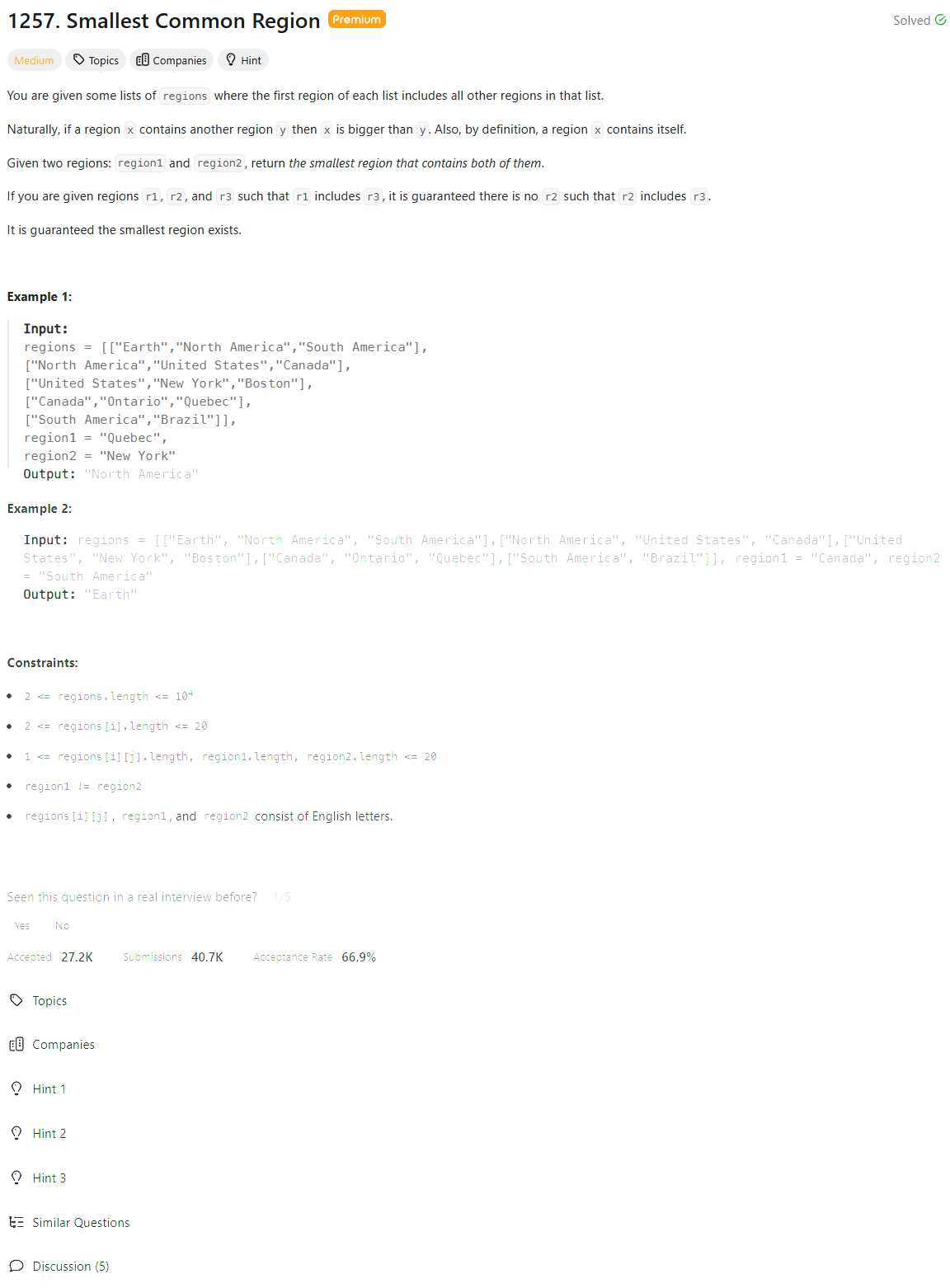Problem of The Day: Smallest Common Region
Problem Statement

Intuition
The problem can be framed as finding the lowest common ancestor (LCA) of two regions in a tree-like structure, where each node represents a region, and its child nodes represent the regions within it. This suggests a recursive approach where we explore the region hierarchy to find the smallest common region.
Approach
- Graph Representation: First, we represent the regions as a directed graph where each region points to its subregions.
- Recursive Search for LCA: We define a recursive function to find the LCA. Starting from the root region, for each subregion, we check if it contains either of the two regions (
region1orregion2). If a region contains both target regions in its subtree, it becomes the lowest common ancestor. - Handling Base Cases: The base case for the recursion is when the current region is one of the target regions (
region1orregion2), which is returned upwards through the recursive calls. - Track the Result: As we traverse the graph, we track whether we’ve found a region that satisfies the condition of being the LCA.
Complexity
-
Time complexity: \(O(n)\), where \(n\) is the number of regions. This is because we traverse the entire graph once to construct it and then traverse it again in a depth-first manner to find the LCA.
-
Space complexity: \(O(n)\), where \(n\) is the number of regions. This is due to the space used by the recursion stack and the adjacency list representation of the graph.
Code
class Solution:
def __init__(self):
self.ans = None
def find_lowest_common_ancestor(self, graph, q, p, curr):
foundedRegions = []
found = curr == q or curr == p
for node in graph[curr]:
foundedRegions.append(self.find_lowest_common_ancestor(graph, q, p, node))
if (found and any(foundedRegions)) or (sum(foundedRegions) >= 2):
self.ans = curr
return any(foundedRegions) or found
def findSmallestRegion(self, regions: List[List[str]], region1: str, region2: str) -> str:
graph = defaultdict(list)
for region in regions:
graph[region[0]] = region[1:]
self.find_lowest_common_ancestor(graph, region1, region2, regions[0][0])
return self.ans
Editorial
Approach: Lowest Common Ancestor of a Generic Tree
class Solution:
# Function to return a list representing the path from the root node
# to the current node.
def fetch_path_for_region(self, curr_node, child_parent_map):
path = []
# Start by adding the current node to the path.
path.append(curr_node)
# Traverse upwards through the tree by finding the parent of the
# current node. Continue until the root node is reached.
while curr_node in child_parent_map:
parent_node = child_parent_map[curr_node]
path.append(parent_node)
curr_node = parent_node
# Reverse the path so that it starts from the root and
# ends at the given current node.
path.reverse()
return path
def findSmallestRegion(
self, regions: List[List[str]], region1: str, region2: str
) -> str:
# Dictionary to store (child -> parent) relationships for each region.
child_parent_map = {}
# Populate the 'child_parent_map' using the provided 'regions' list.
for region_array in regions:
parent_node = region_array[0]
for i in range(1, len(region_array)):
child_parent_map[region_array[i]] = parent_node
# Store the paths from the root node to 'region1' and 'region2'
# nodes in their respective lists.
path1 = self.fetch_path_for_region(region1, child_parent_map)
path2 = self.fetch_path_for_region(region2, child_parent_map)
i, j = 0, 0
lowest_common_ancestor = ""
# Traverse both paths simultaneously until the paths diverge.
# The last common node is the lowest common ancestor.
while i < len(path1) and j < len(path2) and path1[i] == path2[j]:
lowest_common_ancestor = path1[i]
i += 1
j += 1
# Return the lowest common ancestor of 'region1' and 'region2'.
return lowest_common_ancestor
- time: O(m * n)
- space: O(m * n)